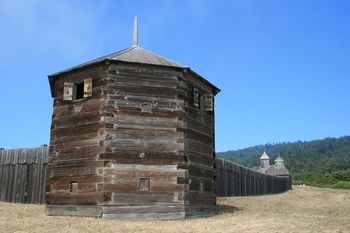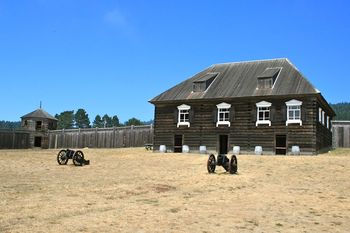Fort Ross
|
Fort Ross (1812-1841) - Originally established in June 1812 by the Russian-American Company as Fort Rossiya. The fort was purchased by Capt. John Sutter in 1841. He disassembled and shipped everything movable to Sacramento for use at Sutter's Fort.
HistoryEstablished in Jun 1812 by a group of 95 Russians and 40 Aleuts as the southernmost trade base of the Russian-American Company, headquartered in Sitka, Alaska. The main purpose was to supply the needs of the Alaska operation. 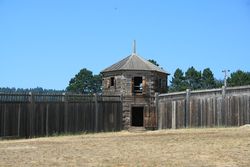 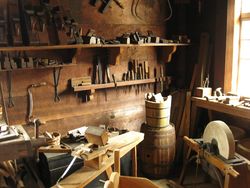 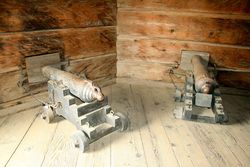 The trading post/fort was laid out in a 276 foot by 312-foot rectangle enclosed by a 14-foot redwood stockade, and guarded by two bastions at opposite corners. The northwest bastion had seven sides and the southeast one had eight, each was two stories high and had ports for cannon. Conflicting accounts indicate that there were between 12 and 40 cannons at the fort but the fort was never threatened by any hostile group. There were more than 50 buildings identified with the fort over time. Inside the stockade were the managers' house, quarters for other officials, barracks for Russian employees, storehouses, a chapel, a magazine, and various other dwellings. There was also a well inside the stockade for emergencies. Outside the stockade were a cattle yard, a bakery, threshing floors, a cemetery, farm buildings, bathhouses, and assorted other structures. There were gardens and an orchard. At the water's edge was a shipyard, a forge, a tannery, and a boathouse. The fort was normally staffed by Russians, Aleuts, and native Kashaya Indians. Records from 1820 indicate that about 60 Russians, 80 Aleuts, and 80 Indians made up the complement at that time and many of those living outside the stockade. The operation was headed by a salaried manager who given living quarters but worked as hard as the other employees. Fort Ross had five managers during its existence:
The climate and the environment were ideal and Manager Rotchev looked back at his time in this "enchanting land" as the "best years" of his life. Late in 1839, the inhabitants of Fort Ross were ordered by the Russian-American Company to sell the fort and its contents and return to Alaska. Negotiations with bidders went on until Capt. John Sutter successfully bid $30,000 in gold and produce for the fort and its property. Sutter moved everything possible to Sutter's Fort at Sacramento between 1841 and 1845. In 1845 the fort became the center of large ranch that was purchased by the G.W. Call family in 1874. The fort's remaining buildings were left abandoned until 1906 when it was acquired by the state of California.
Current StatusPart of Fort Ross State Park. A Greek Orthodox chapel, commandant's quarters and stockade are among the reconstructed buildings. The only surviving structure, the Rotchev house, was renovated about 1836 for Alexander Rotchev who was the last manager of Fort Ross. Period cannons and reproductions in place. Beautiful setting. Must see!
Sources:
Links:
Visited: 17 Aug 2009 Picture Gallery
| ||||||
